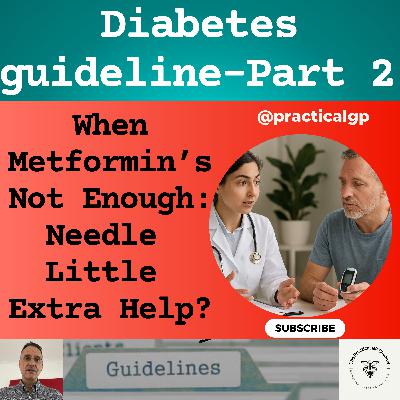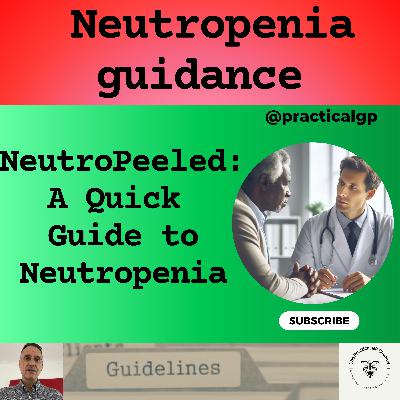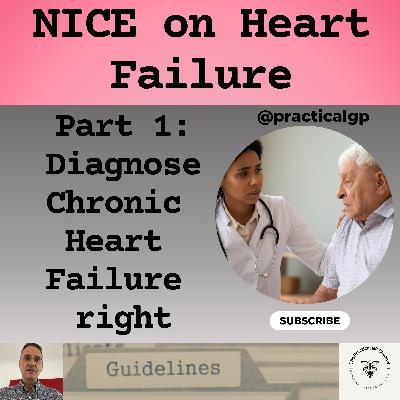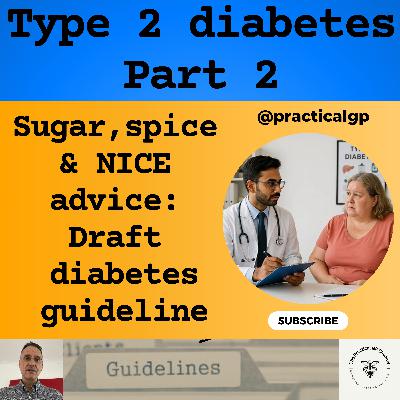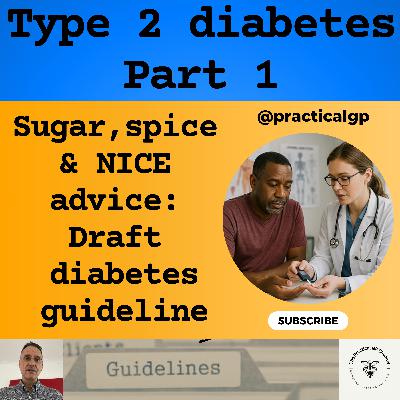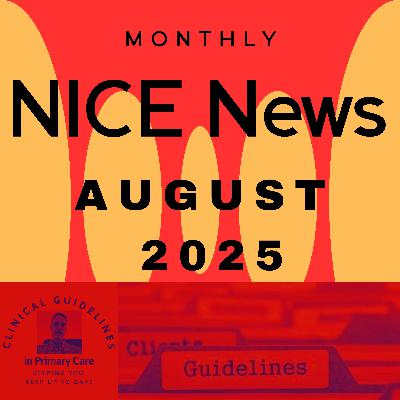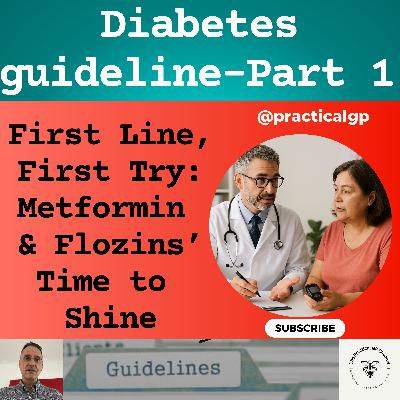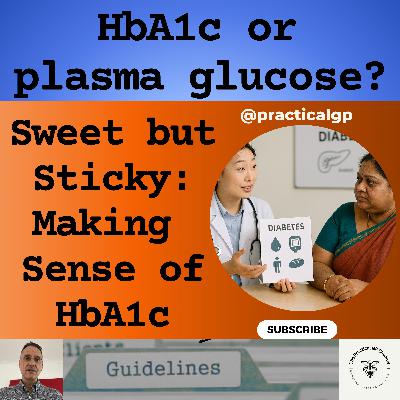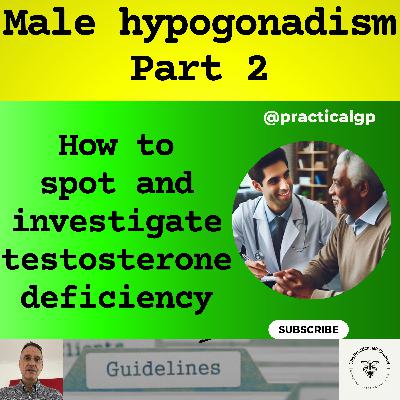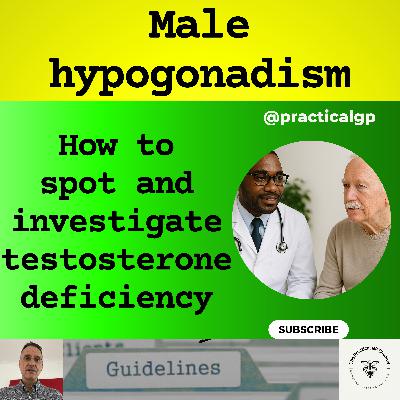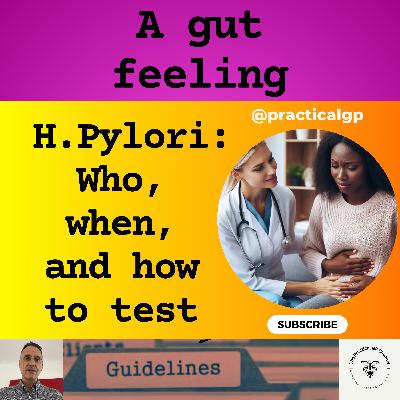Podcast - T2DM guideline – Part 2 - When Metformin’s Not Enough: Needle Little Extra Help?
Description
The video version of this podcast can be found here:
· https://youtu.be/z7eZ1MLItGw
The previous episode on first line treatment of T2DM can be found here:
· https://youtu.be/32Lf5UlyTOA
This episode makes reference to guidelines produced by the "National Institute for Health and Care Excellence" in the UK, also referred to as "NICE". The content on this channel reflects my professional interpretation/summary of the guidance and I am in no way affiliated with, employed by or funded/sponsored by them.
NICE stands for "National Institute for Health and Care Excellence" and is an independent organization within the UK healthcare system that produces evidence-based guidelines and recommendations to help healthcare professionals deliver the best possible care to patients, particularly within the NHS (National Health Service) by assessing new health technologies and treatments and determining their cost-effectiveness; essentially guiding best practices for patient care across the country.
My name is Fernando Florido and I am a General Practitioner in the United Kingdom. In this episode I go through the NICE recommendations on the drug treatment of type 2 diabetes, included in the NICE guideline NG28. The links to the NICE guideline can be found below.
In today’s episode, we are focusing on treatment options if further interventions are needed after first line treatment. If you haven’t already, I recommend that you check the previous episode on the first line drug management of type 2 diabetes.
I am not giving medical advice; this video is intended for health care professionals, it is only my summary and my interpretation of the guidelines and you must use your clinical judgement.
Disclaimer:
The Video Content on this channel is for educational purposes and not intended to be a substitute for professional medical advice, diagnosis, or treatment. Always seek the advice of your physician or other qualified health provider with any questions you may have regarding a medical condition. Never disregard professional medical advice or delay in seeking it because of something you have read or seen on this YouTube channel. The statements made throughout this video are not to be used or relied on to diagnose, treat, cure or prevent health conditions.
In addition, transmission of this Content is not intended to create, and receipt by you does not constitute, a physician-patient relationship with Dr Fernando Florido, his employees, agents, independent contractors, or anyone acting on behalf of Dr Fernando Florido.
Intro / outro music: Track: Halfway Through — Broke In Summer [Audio Library Release]
- Music provided by Audio Library Plus
- Watch: https://youtu.be/aBGk6aJM3IU
- Free Download / Stream: https://alplus.io/halfway-through
There is a podcast version of this and other videos that you can access here:
Primary Care guidelines podcast:
· Redcircle: https://redcircle.com/shows/primary-care-guidelines
· Spotify: https://open.spotify.com/show/5BmqS0Ol16oQ7Kr1WYzupK
· Apple podcasts: https://podcasts.apple.com/gb/podcast/primary-care-guidelines/id1608821148
There is a YouTube version of this and other videos that you can access here:
- The Practical GP YouTube Channel:
https://youtube.com/@practicalgp?si=ecJGF5QCuMLQ6hrk
The NICE guideline on Type 2 diabetes in adults: management [NG28] can be found here:
· https://www.nice.org.uk/guidance/ng28
Transcript
If you are listening to this podcast on YouTube, for a better experience, switch to the video version. The link is in the top right corner of the video and in the episode description.
Hello and welcome! I’m Fernando, a GP in the UK. In this episode, we’ll go through the NICE recommendations on the drug treatment of type 2 diabetes, included in the NICE guideline NG28. The link to it is in the episode description.
In today’s episode, we are focusing on glucose lowering treatment options if further interventions are needed after first line treatment.
If you haven’t already, I recommend that you check the previous episode on the first line drug management of type 2 diabetes.
Right, let’s jump into it.
So we are going to look at treatment options if further intervention is needed—basically, what to do after first-line treatment.
But first, let’s talk about reviewing drug treatments and when we will need to add an SGLT2 inhibitor at any point after starting first-line therapy.
For adults with type 2 diabetes, no matter where they are in their treatment journey, if they have or develop chronic heart failure, established atherosclerotic cardiovascular disease, or become high risk for cardiovascular disease, if they are not already on it, we should offer an SGLT2 inhibitor that has proven cardiovascular benefits. This can be added on to their current treatment or used to replace an existing medication.
And let’s remember that this is because there is strong evidence in large randomised controlled trials, that has shown that SGLT2 inhibitors not only improve blood glucose control but also reduce the risk of hospitalisation for heart failure, and in some cases lower cardiovascular mortality. These benefits are seen even in patients without diabetes, which highlights their role in protecting the cardiovascular system as well as the kidneys.
Right, now, before we look into how to intensify treatment, let’s quickly cover what NICE says about monitoring and targets.
Regarding diabetes monitoring, NICE recommends measuring HbA1c every 3 to 6 months until it’s stable on unchanging treatment. After that, once HbA1c is fully stable, measuring every 6 months is usually enough.
When it comes to HbA1c targets, we should discuss and agree on an individual goal with each patient. The aim is to help them reach and maintain that target—unless trying to do so causes problems like hypoglycaemia or lowers their quality of life.
Generally speaking, for those managing their diabetes with lifestyle changes or a single drug that doesn’t cause hypoglycaemia, the target is around 48 mmol/mol, or 6.5%. For patients on medications that do carry a risk of hypoglycaemia, the target is a bit higher, around 53 mmol/mol, or 7.0%.
If an adult’s HbA1c isn’t controlled by a single drug and rises to 58 mmol/mol, or 7.5%, or above, then we need to review and reinforce their current treatment and after that, we usually move to intensify drug treatment by adding a second medication.
Now let’s look at treatment options when further intervention is needed.
For adults with type 2 diabetes, if monotherapy isn’t enough to keep HbA1c below their individual target, we can consider adding one of the following:
· a DPP-4 inhibitor,
· pioglitazone,
· a sulfonylurea,
· or an SGLT2 inhibitor.
If dual therapy—usually metformin plus another oral drug—still isn’t controlling HbA1c below the agreed threshold, then we have two main options. We can either:
· move to triple therapy by adding a DPP-4 inhibitor, pioglitazone, a sulfonylurea, or an SGLT2 inhibitor,
· or we can consider starting insulin.
In adults with type 2 diabetes, if metformin is contraindicated or not tolerated, and dual therapy with two oral drugs still isn’t keeping HbA1c below the agreed threshold, then insulin should be considered. This essentially means that triple therapy is only recommended by NICE when one of those three drugs is metformin, not otherwise
If triple therapy with metformin and two other oral drugs isn’t effective, isn’t tolerated, or is contraindicated, we may consider switching one of those drugs for a GLP-1 mimetic—but according to NICE, this is only for adults who:
- Have a BMI of 35 or higher (with adjustments for people from Black, Asian, and other minority ethnic groups by reducing the BMI by 2.5 to 32.5) and who also have specific psychological or medical problems linked to obesity, or
- Have a BMI under 35 but for whom insulin would have significant occupational impacts, or where weight loss would help other serious obesity-related health issues.
GLP-1 mimetic therapy should only be continued if the patient shows a clear benefit, that is, a drop in HbA1c of at least 11 mmol/mol (or 1%) and a weight loss of at least 3% of their starting body weight within six months.
Also, we need to be aware that combining a GLP-1 mimetic with insulin should only be done under specialist

